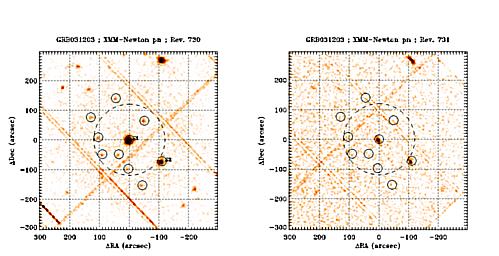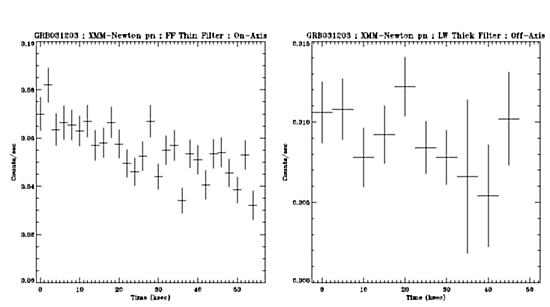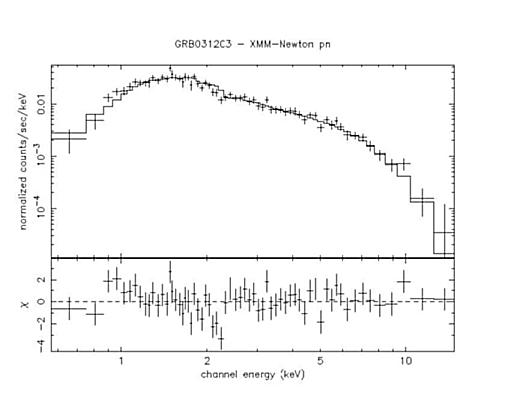grb031203 - XMM-Newton
XMM-Newton Observation of GRB031203
Events
- GRB031203 was discovered by INTEGRAL on December 03, 2003 at 22:01 UTC in the field of view of the IBIS telescope (Gotz et al. GCN2459).
- The notification arrived to VILSPA at 22:03 UTC, and following a quick evaluation, the GRB was approved by XMM-Newton Project Scientist for a ToO observation at the beginning of revolution 730.
- The observation was started on 2003-12-04 at 03:52:00.UT under ObsId=0158160201, just 5 Hrs 51 mins. after the occurrence of the burst, and lasting for a total of 59.3 ksec. This has been the fastest XMM-Newton ToO response to date. The pointing coordinates were RA=08:02:30.0, Dec=-39:50:48 as reported in GCN2459.
- Already after the first 5000 sec of exposure, two sources were clearly present in the pn and MOS field of view (Santos-Lleo and Calderon GCN2464).
The strongest source (0.1 counts/sec in EPIC-pn) was at RA=08:02:30.2, Dec=-39:51:03 . This position is already based on the reconstituted Attitude History File and subject to an uncertainty of about 3 arcseconds.
There was a second, fainter source, at RA=08:02:20.7, Dec=-39:52:15. - These coordinates were within the EPIC field of view for a calibration observation of Zeta Pup, scheduled for the next revolution 731. Therefore, we have been able to collect another 53.6ks on the expected location of GRB031203 under ObsId 0163360201, though at a large (6arcmin) off-axis angle.
- For the optical counterparts of GRB031203 the reader may go through the GCN circulars. We will just mention that the final coordinates of the brightest, variable S1 source agrees within errors with the position of the radio source detected with VLA (GCN2473) and the infrared source reported in GCN2475 and GCN2479
Data
- The Observation Data File (ODF) is available in the XSA here or in the ftp server.
- The Pipeline Products are also available in the XSA here.
- Details of the Pipeline process are available here
- The Observation Data File (ODF) for ObsId 0163360201 is available in the XSA here or in the ftp server.
- The Pipeline Products are available in here.
- Details of the Pipeline process are available here
Quick analysis of preliminary XMM-Newton data
The images are centered at the IBAS position of GRB031203 and its reported uncertainty is marked by the dashed circle.
The re-measured positions of the sources listed in the circular GCN2474 are shown by the 10arcsec open circles. Sources S1 and S2 mentioned in GCN2464 are explicitly labelled.
As expected from the XMM-Newton pointing accuracy, the coordinates once the Attitude History has been reconstituted differ from the coordinates reported in previous circulars by 2-3arcsec.
08 02 30.2 -39 51 03 (S1)
08 02 20.7 -39 52 15 (S2)
08 02 25.9 -39 49 58
08 02 30.6 -39 52 41
08 02 33.3 -39 51 52
08 02 38.1 -39 51 52
08 02 39.3 -39 50 54
08 02 34.1 -39 48 42
08 02 41.6 -39 49 46
08 02 26.5 -39 53 35
EPIC-pn image
A minimum event filtering has been selected to generate these images; a further image filtering has been applied to enhance weak sources. The overall higher background in the second observation significantly reduces the signal-to-noise ratio in most sources.
PN light curve
PN light curve of S1 between 0.3 and 7 keV (background subtracted). Already in the first observation the count rate decreased by ~40%. Due to the different observing modes, filter and off-axis angle, the comparison of the count rates in the first and second observations requires a further detailed analysis. However, all these effects may account for a decrease of a factor ~2 in the count rate but cannot explain by themselves the factor of ~8 observed.
EPIC-pn spectrum
The pn spectrum of GRB031203 is heavily absorbed below 1keV, consistent with an Hydrogen column density of ~9 1021 cm-2, slightly higher than the galactic value of ~7 1021 cm-2 in this direction. The flux in the 2-10 keV band is approximately 3.6 10 -13 erg cm-2 s-1
A single absorbed power law may not be enough to fully describe the X-ray spectrum of GRB031203; some structure seems to be present in the residuals of the fit to such a simple model.
- Removed a total of (1) style text-align:center;
- Converted a total of (3) center to div.








































 Sign in
Sign in
 Science & Technology
Science & Technology


